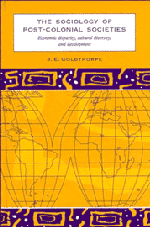Book contents
- Frontmatter
- Contents
- Preface and acknowledgements
- 1 Introduction and argument
- 2 Technology, society, and population
- 3 The colonial episode and the race question
- 4 Economic conditions
- 5 Environmental concerns
- 6 The social sciences and the ‘Third World’
- 7 The rise of towns
- 8 Family life in a changing world: two studies
- 9 Cultural diversity, language, education, and communications
- 10 Religion and development
- 11 Individual modernization: some psychological studies
- 12 Politics in post-colonial states
- 13 Aid and development
- Notes
- Index
1 - Introduction and argument
Published online by Cambridge University Press: 03 May 2011
- Frontmatter
- Contents
- Preface and acknowledgements
- 1 Introduction and argument
- 2 Technology, society, and population
- 3 The colonial episode and the race question
- 4 Economic conditions
- 5 Environmental concerns
- 6 The social sciences and the ‘Third World’
- 7 The rise of towns
- 8 Family life in a changing world: two studies
- 9 Cultural diversity, language, education, and communications
- 10 Religion and development
- 11 Individual modernization: some psychological studies
- 12 Politics in post-colonial states
- 13 Aid and development
- Notes
- Index
Summary
Disparity and development
The transformation of human life through the application of science has been an uneven process, revolutionizing some societies and some aspects of human activity before others. From the outset we may distinguish the application of science to health, notably to public health and preventive medicine as well as to individual curative medicine; and to production, notably including agriculture as well as mining, construction, transport, manufacturing, etc., which we generally class together as ‘industry’. Development, widely understood, refers to the whole process of transition, in which there has been a tendency in the past to over-emphasize the growth of modern industry (industrialization, the Industrial Revolution). As Ernest Gellner well said, the language of economic growth ‘is misleading in as far as it suggests that what is at stake is something quantitative, a rate or speed or quantity of accumulation of goods. Ultimately, what is at stake is something qualitative – a transition between two fundamentally different forms of life.’
Nonetheless, it is the transformation of production that has been associated with the wide and increasing disparity among rich and poor countries, and among rich and poor people in the world as a whole, that constitutes a central theme of this book. The disparities are especially stark within poor countries, where a few wealthy families can emulate the affluent life-styles of the well-to-do in rich countries, while the great majority live at or near a bare subsistence.
- Type
- Chapter
- Information
- The Sociology of Post-Colonial SocietiesEconomic Disparity, Cultural Diversity and Development, pp. 1 - 16Publisher: Cambridge University PressPrint publication year: 1996



